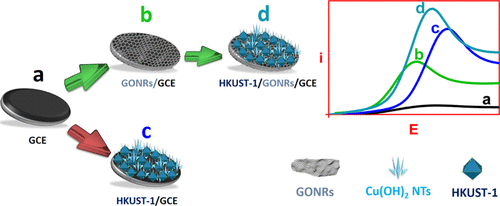当前位置:
X-MOL 学术
›
ACS Appl. Mater. Interfaces
›
论文详情
Our official English website, www.x-mol.net, welcomes your feedback! (Note: you will need to create a separate account there.)
In Situ Growth of Metal-Organic Framework HKUST-1 on Graphene Oxide Nanoribbons with High Electrochemical Sensing Performance in Imatinib Determination.
ACS Applied Materials & Interfaces ( IF 9.5 ) Pub Date : 2020-01-16 , DOI: 10.1021/acsami.9b18097 Nahid Rezvani Jalal 1 , Tayyebeh Madrakian 1 , Abbas Afkhami 1 , Arash Ghoorchian 1
ACS Applied Materials & Interfaces ( IF 9.5 ) Pub Date : 2020-01-16 , DOI: 10.1021/acsami.9b18097 Nahid Rezvani Jalal 1 , Tayyebeh Madrakian 1 , Abbas Afkhami 1 , Arash Ghoorchian 1
Affiliation

|
Metal-organic frameworks (MOFs) have been previously investigated as electrode materials for developing electrochemical sensors. They have usually been reported to suffer from poor conductivity and improvement in the conductivity of MOFs is still a great challenge. Here, we reported the fabrication of an electrochemical sensor based on the in situ growth of framework HKUST-1 on conductive graphene oxide nanoribbons (GONRs)-modified glassy carbon electrode (GCE) (HKUST-1/GONRs/GCE). The as-fabricated modified electrode was characterized using field emission scanning electron microscopy, transmission electron microscopy (TEM), high-resolution TEM, Fourier transform infrared, X-ray diffraction, electrochemical impedance spectroscopy, cyclic voltammetry, and Raman spectroscopy. The voltammetric response of HKUST-1/GONRs/GCE toward Imatinib (IMA), as an anticancer drug, is dramatically higher than HKUST-1/GCE because of the synergic effect of the GONRs and HKUST-1 framework. The calibration curve at the HKUST-1/GONRs/GCE for IMA covered two linear dynamic ranges, 0.04-1.0 and 1.0-80 μmol L-1, with a detection limit of 0.006 μmol L-1 (6 nmol L-1). Taking advantage of the conductivity of GONRs and large surface area of HKUST-1, a sensitive modified electrode was developed for the electrochemical determination of IMA. The present method provides an effective strategy to solve the poor conductivity of the MOFs. Finally, the obtained electrochemical performance made this modified electrode promising in the determination of IMA in urine and serum samples.
中文翻译:

伊马替尼测定中具有高电化学感应性能的氧化石墨烯纳米带上金属有机骨架HKUST-1的原位生长。
先前已经研究了金属有机框架(MOF)作为开发电化学传感器的电极材料。通常已经报道它们具有差的导电性,并且MOF的导电性的改善仍然是巨大的挑战。在这里,我们报道了基于在导电氧化石墨烯纳米带(GONRs)修饰的玻碳电极(GCE)(HKUST-1 / GONRs / GCE)上框架HKUST-1原位生长的电化学传感器的制造。使用场发射扫描电子显微镜,透射电子显微镜(TEM),高分辨率TEM,傅立叶变换红外光谱,X射线衍射,电化学阻抗谱,循环伏安法和拉曼光谱法对制成的修饰电极进行表征。HKUST-1 / GONRs / GCE对伊马替尼(IMA)的伏安响应,由于GONRs和HKUST-1框架的协同作用,它作为一种抗癌药物远高于HKUST-1 / GCE。IMA的HKUST-1 / GONRs / GCE的校准曲线涵盖两个线性动态范围,即0.04-1.0和1.0-80μmolL-1,检测极限为0.006μmolL-1(6 nmol L-1)。利用GONRs的电导率和HKUST-1的大表面积,开发了一种灵敏的修饰电极用于IMA的电化学测定。本方法提供了解决MOF导电性差的有效策略。最后,获得的电化学性能使该修饰电极在尿液和血清样品中IMA的测定方面很有希望。IMA的HKUST-1 / GONRs / GCE的校准曲线涵盖两个线性动态范围,即0.04-1.0和1.0-80μmolL-1,检测极限为0.006μmolL-1(6 nmol L-1)。利用GONRs的电导率和HKUST-1的大表面积,开发了一种灵敏的修饰电极用于IMA的电化学测定。本方法提供了解决MOF导电性差的有效策略。最后,获得的电化学性能使该修饰电极在尿液和血清样品中IMA的测定方面很有希望。IMA的HKUST-1 / GONRs / GCE的校准曲线涵盖两个线性动态范围,即0.04-1.0和1.0-80μmolL-1,检测极限为0.006μmolL-1(6 nmol L-1)。利用GONRs的电导率和HKUST-1的大表面积,开发了一种灵敏的修饰电极用于IMA的电化学测定。本方法提供了解决MOF导电性差的有效策略。最后,获得的电化学性能使该修饰电极在尿液和血清样品中IMA的测定方面很有希望。开发了灵敏的修饰电极用于IMA的电化学测定。本方法提供了解决MOF导电性差的有效策略。最后,获得的电化学性能使该修饰电极在尿液和血清样品中IMA的测定方面很有希望。开发了灵敏的修饰电极用于IMA的电化学测定。本方法提供了解决MOF导电性差的有效策略。最后,获得的电化学性能使该修饰电极在尿液和血清样品中IMA的测定方面很有希望。
更新日期:2020-01-17
中文翻译:

伊马替尼测定中具有高电化学感应性能的氧化石墨烯纳米带上金属有机骨架HKUST-1的原位生长。
先前已经研究了金属有机框架(MOF)作为开发电化学传感器的电极材料。通常已经报道它们具有差的导电性,并且MOF的导电性的改善仍然是巨大的挑战。在这里,我们报道了基于在导电氧化石墨烯纳米带(GONRs)修饰的玻碳电极(GCE)(HKUST-1 / GONRs / GCE)上框架HKUST-1原位生长的电化学传感器的制造。使用场发射扫描电子显微镜,透射电子显微镜(TEM),高分辨率TEM,傅立叶变换红外光谱,X射线衍射,电化学阻抗谱,循环伏安法和拉曼光谱法对制成的修饰电极进行表征。HKUST-1 / GONRs / GCE对伊马替尼(IMA)的伏安响应,由于GONRs和HKUST-1框架的协同作用,它作为一种抗癌药物远高于HKUST-1 / GCE。IMA的HKUST-1 / GONRs / GCE的校准曲线涵盖两个线性动态范围,即0.04-1.0和1.0-80μmolL-1,检测极限为0.006μmolL-1(6 nmol L-1)。利用GONRs的电导率和HKUST-1的大表面积,开发了一种灵敏的修饰电极用于IMA的电化学测定。本方法提供了解决MOF导电性差的有效策略。最后,获得的电化学性能使该修饰电极在尿液和血清样品中IMA的测定方面很有希望。IMA的HKUST-1 / GONRs / GCE的校准曲线涵盖两个线性动态范围,即0.04-1.0和1.0-80μmolL-1,检测极限为0.006μmolL-1(6 nmol L-1)。利用GONRs的电导率和HKUST-1的大表面积,开发了一种灵敏的修饰电极用于IMA的电化学测定。本方法提供了解决MOF导电性差的有效策略。最后,获得的电化学性能使该修饰电极在尿液和血清样品中IMA的测定方面很有希望。IMA的HKUST-1 / GONRs / GCE的校准曲线涵盖两个线性动态范围,即0.04-1.0和1.0-80μmolL-1,检测极限为0.006μmolL-1(6 nmol L-1)。利用GONRs的电导率和HKUST-1的大表面积,开发了一种灵敏的修饰电极用于IMA的电化学测定。本方法提供了解决MOF导电性差的有效策略。最后,获得的电化学性能使该修饰电极在尿液和血清样品中IMA的测定方面很有希望。开发了灵敏的修饰电极用于IMA的电化学测定。本方法提供了解决MOF导电性差的有效策略。最后,获得的电化学性能使该修饰电极在尿液和血清样品中IMA的测定方面很有希望。开发了灵敏的修饰电极用于IMA的电化学测定。本方法提供了解决MOF导电性差的有效策略。最后,获得的电化学性能使该修饰电极在尿液和血清样品中IMA的测定方面很有希望。


























 京公网安备 11010802027423号
京公网安备 11010802027423号